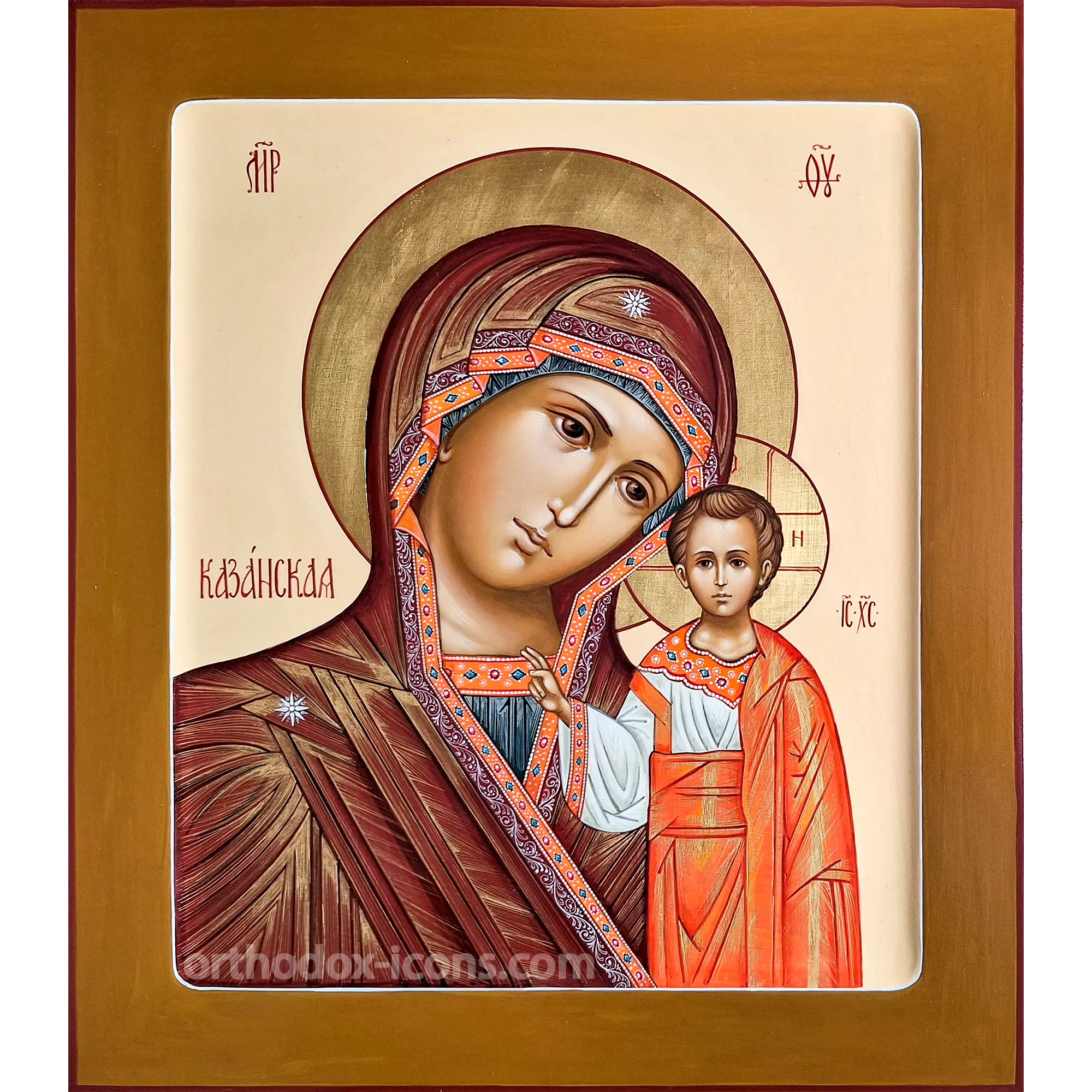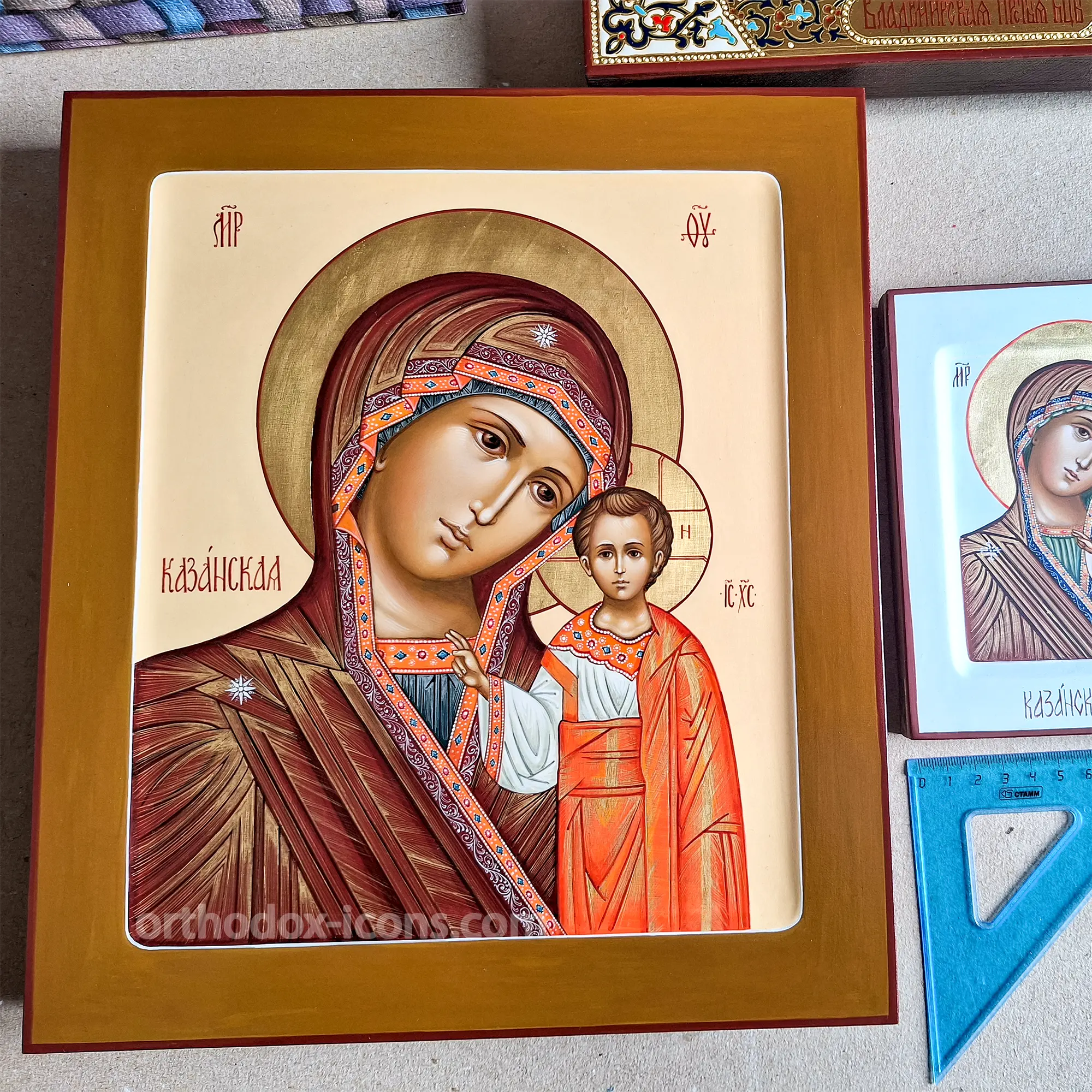Hand-Painted Icon of the Kazan Mother of God
$350 – $1300Price range: $350 through $1300
The Hand-Painted Icon of the Kazan Mother of God will be meticulously handcrafted for you at the Mstyora Icons Workshop, following the sacred traditions of Russian iconography.
-
Linden wood board with mortise-and-tenon joints for durability.
-
Natural materials: Pavoloka (linen), chalk levkas, 23K gold leaf (960 purity) by Manetti (Italy).
-
Egg tempera paints (handmade pigments on egg yolk).
-
Protective lacquer for longevity.
-
Hand-painted on wood by master iconographers.
-
Strict adherence to the Russian Orthodox canon.
-
Layered tempera application for luminous, enduring colors.
Each icon is a unique spiritual work of art, blessed by tradition and crafted with reverence.
It is possible to paint an image in any size to order
Free shipping worldwide
Hand-Painted Christian Wall Art of the Kazan Mother of God
A reverently Hand-Painted Icon of the Kazan Mother of God, created with natural mineral pigments in egg tempera on a seasoned wooden panel, enhanced with genuine gold leaf and traditional ornament. This most revered Marian icon depicts the Theotokos holding the Christ Child, both facing the viewer with expressions of divine tenderness and mercy. The composition follows the canonical Hodegetria type while embodying the unique characteristics that have made the Kazan icon Russia’s most beloved image of the Mother of God and a symbol of national protection.
Who Is Depicted: The Kazan Mother of God
The Kazan Mother of God is one of the most venerated icons in Orthodox Christianity, particularly cherished in Russian tradition as the “Holy Protectress of Russia.” According to sacred tradition, the icon was discovered miraculously in Kazan in 1579, when the Virgin Mary appeared to a young girl named Matrona, directing her family to find the buried icon beneath their fire-damaged home. The discovery was accompanied by numerous healings, particularly of blindness and eye ailments, establishing the icon’s reputation for miraculous intercession.
Throughout Russian history, the Kazan icon has been credited with protecting the nation during times of crisis. Military commanders Dmitry Pozharsky and Mikhail Kutuzov attributed victories over Polish invaders (1612), Swedish forces (1709), and Napoleon’s army (1812) to the Mother of God’s intercession through this holy image. The icon serves as both spiritual refuge for individuals and national palladium for the Russian people, embodying maternal protection and divine mercy.
Iconographic Composition and Symbolism
This sacred composition presents the Mother of God in three-quarter length, holding the Christ Child who appears in full frontal view. Both figures face the viewer directly, creating an intimate encounter that invites personal prayer and devotion. The image belongs to the Hodegetria type but with distinctive characteristics that mark it as authentically Kazan.
- The Mother’s Gaze: Tender yet penetrating, conveying both maternal compassion and royal dignity as Queen of Heaven.
- Christ Child’s Blessing: The young Christ extends His right hand in blessing while often holding a scroll, symbolizing His role as Teacher and Word of God.
- Royal Vestments: The Theotokos wears the traditional maphorion with three stars, indicating her perpetual virginity, while rich decorative patterns emphasize her queenly status.
- Golden Background: The luminous gold field represents the uncreated light of God’s kingdom and the heavenly realm from which the saints intercede.
- Intimate Scale: Traditionally painted in smaller formats, the icon emphasizes personal devotion and family protection rather than monumental church display.
Hand-Painted Icon of the Kazan Mother of God: Materials and Technique
This Hand-Painted Icon of the Kazan Mother of God exemplifies the refined artistry of the Mstyora school, known for delicate facial modeling, rich color harmonies, and precise ornamental work that enhances rather than distracts from spiritual contemplation.
- Wooden Panel: Seasoned linden wood prepared with linen backing and multiple layers of chalk gesso (levkas) for optimal durability and paint receptivity.
- Gold Leaf Application: Genuine 23-karat gold leaf over bole, carefully burnished and optionally tooled to create the luminous background and halos characteristic of Orthodox iconography.
- Egg Tempera: Natural mineral pigments mixed with egg yolk, applied in successive transparent layers that build form through light rather than shadow, following traditional Byzantine technique.
- Ornamental Details: Intricate decorative patterns on vestments and borders executed with precision to honor both the Theotokos and the canonical tradition.
- Protective Varnish: Natural protective coating preserves the tempera colors and gold leaf while maintaining the icon’s spiritual luminosity.
Miraculous Tradition and Spiritual Significance
The Kazan Mother of God is particularly invoked for protection from enemies, healing of eye diseases, family harmony, and guidance during national crises. Orthodox tradition credits this icon with countless miracles, from individual healings to protecting entire cities and nations. The image is especially beloved by mothers, who seek the Theotokos’s protection for their children, and by those facing seemingly impossible situations.
Many faithful report experiencing profound peace and sense of protection when praying before this icon. The traditional association with eye healing extends to spiritual vision—helping believers see clearly through difficulties and discern God’s will in challenging circumstances. The icon’s role in Russian military victories has also made it a source of courage for those facing personal battles.
Historical Context and National Importance
The discovery of the Kazan icon in 1579 coincided with Russia’s expansion and consolidation under Ivan the Terrible. The icon’s subsequent role in national defense—particularly during the Time of Troubles (1598-1613) when Prince Pozharsky carried it into battle against Polish invaders—established it as a symbol of Russian Orthodox identity and divine protection. This historical significance continues to resonate, making the icon meaningful not only for personal devotion but also for understanding Russian spiritual and cultural identity.
The theft of the original icon in 1904 was interpreted by many as a prophetic sign of coming tribulations, including the Russian Revolution and subsequent Soviet persecution of the Church. The return of a historical copy from the Vatican to Kazan in 2004 was seen as a sign of spiritual renewal and reconciliation.
Visible Details: Artistic Excellence and Spiritual Beauty
- Facial Modeling: Subtle transitions from dark sankir to flesh tones create spiritually luminous faces that convey both divine majesty and human tenderness.
- Textile Rendering: Rich maphorion and child’s garments displayed with careful attention to traditional iconographic conventions and decorative details.
- Hand Positioning: The gentle embrace of Mother and Child creates visual harmony while the blessing gesture establishes theological meaning.
- Color Harmony: Traditional palette of deep blues, reds, and golds balanced to create visual rhythm supporting extended prayer and contemplation.
Creating the Icon: Step-by-Step Process
- Panel Preparation: Selection of seasoned wood, application of linen backing, and careful layering of levkas ground to create optimal painting surface.
- Design Transfer: Precise placement of canonical proportions ensuring theological accuracy and visual balance between Mother and Child.
- Gilding Process: Application of bole, laying of gold leaf, and burnishing to create the luminous heavenly background characteristic of the type.
- Figure Development: Building both figures through traditional tempera techniques, from dark underpainting to luminous spiritual highlights.
- Ornamental Work: Addition of decorative patterns, vestment details, and ornamental borders that honor the icon’s regal significance.
- Final Elements: Canonical inscriptions, final protective varnish, and quality inspection ensuring spiritual and artistic integrity.
Placement and Veneration in Orthodox Homes
The Kazan Mother of God traditionally holds a central place in Orthodox family prayer corners, often positioned where it can oversee daily family life. Many Orthodox families place the icon over children’s beds, seeking the Mother of God’s protection during sleep. The image also traditionally blesses newlyweds and new homes, establishing divine protection over family life from its beginning.
Why the Hand-Painted Icon of the Kazan Mother of God Enriches Family Life
The presence of this Hand-Painted Icon of the Kazan Mother of God in the home creates a tangible connection to centuries of miraculous intercession and national protection. Unlike mass-produced religious images, this hand-painted icon carries the prayer and devotion of skilled iconographers, making it a true spiritual heirloom. The traditional materials and techniques ensure the icon will maintain its beauty and spiritual presence for generations, becoming a source of family strength and divine protection.
Feast Days and Liturgical Celebration
The Orthodox Church celebrates the Kazan Mother of God on July 21st and November 4th, with the latter date also serving as Russia’s Day of National Unity. These celebrations include special services, processions, and renewed veneration that connects contemporary believers with the icon’s historical role in national protection and spiritual renewal.
Customization and Commissioning Options
The Mstyora workshop can create this icon in various sizes for different devotional contexts, from intimate family icons to larger church panels. Options include personalized dedications, coordinated sets with other protective Marian icons, or adaptations for specific family or church requirements. All customizations maintain strict adherence to Orthodox canons while accommodating individual spiritual needs.
Care and Preservation Guidelines
- Environmental Protection: Keep away from direct sunlight and maintain stable temperature and humidity levels to preserve the protective varnish and gold leaf.
- Gentle Cleaning: Use only soft brushes for dusting; avoid chemical cleaners that could damage the delicate varnish layer.
- Proper Positioning: Place where the icon can be easily venerated but protected from accidental damage or excessive handling.
- Long-term Care: The protective varnish maintains color stability and gold leaf brilliance when properly maintained, ensuring the icon’s continued spiritual presence.
The Mstyora Workshop Excellence
The Mstyora workshop’s particular expertise in creating canonical Marian icons makes it ideally suited for producing authentic Kazan Mother of God images. The combination of centuries-old techniques with deep theological understanding ensures each icon serves as both artistic masterpiece and genuine spiritual gateway. The workshop’s reputation for maintaining strict Orthodox canons while achieving artistic excellence makes it a preferred choice for families and churches seeking authentic iconographic art.
Welcome the miraculous protection and maternal love of the Kazan Mother of God into your home or church—order this hand-painted icon from the Mstyora Workshop with free worldwide shipping by post and convenient payment by Visa/Mastercard upon delivery.
| Dimensions | 13x16cm (5.1×6.3 in) ,17x21cm (6.7×8.3 in) ,27x31cm (10.6×12.2 in) ,30x40cm (11.8×15.7 in) ,20x24cm (7.9×9.4 in) |
|---|---|
| Name | Mary |
Related products
Virgin Mary Vladimir Orthodox Icon
Available on backorder
$300 – $1500Price range: $300 through $1500Bethlehem Icon of Mother of God
Available on backorder
$300 – $1300Price range: $300 through $1300Vladimir Icon of GodMother
Available on backorder
$300 – $1400Price range: $300 through $1400Vladimir Mother of God Icon
Available on backorder
$300 – $1300Price range: $300 through $1300Vladimir Theotokos Orthodox Icon
Available on backorder
$200 – $1100Price range: $200 through $1100Vladimir Icon of Mother Mary
Available on backorder
$200 – $1200Price range: $200 through $1200
